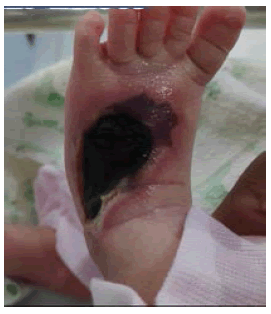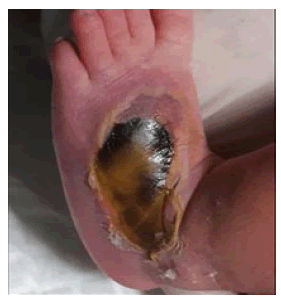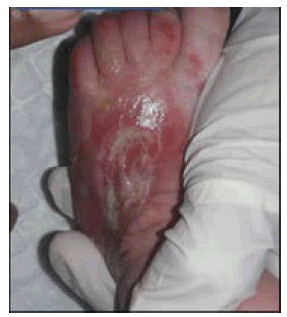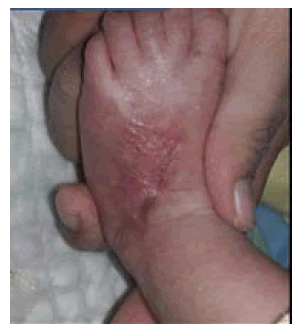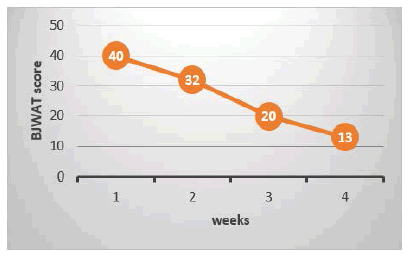Research Article - Clinical Practice (2021) Volume 18, Issue 7
Extravasation Wound Care Management: A Case study in Infant
- Corresponding Author:
- Suriadi
Postgraduate Nursing Program
Institute of Nursing Muhamadiyah Pontianak, Indonesia
E-mail: kharisma@stikmuhptk.ac.i; suriadif@yahoo.com.au
Abstract
Introduction: Extravasation wound is the leakage of drugs or fluids into the subcutaneous tissue from the veins or vascular tissue, mainly causing tissue damage. Extravasation wound events involve severe complications, such as the progression of a relatively mild wound (tissue edema, redness, or vasculitis) to skin necrosis or an abscess. Here study, Extravasation wound care management with autolysis debridement on eschar or slough tissue applied to promote the wound healing. This study was to evaluate the effectiveness of hydrogel and alginate for the treatment of extravasation wounds in an infant. Method: the study applied hydrogel and alginate dressing. The nurse applied hydrogel and alginate as a primary dressing and covered them with minimal absorbent as a secondary dressing. The nurse used the Bates-Jansen Wound Assessment Tool (BJWAT) to observe the wound progress. Result: two weeks following the treatment, necrotic tissue was autolyzed. The granulation tissue looked abundant, signs of inflammation and slough were reduced, and the wound was healed completely. Conclusion: The BJWAT showed the score was decreased. It means that the autolysis debridement by using gel and alginate is effectively reducing slough necrotic tissues and promote the wound healing process.
Keywords
extravasation wound, wound management, wound care
Introduction
An extravasation wound is the leakage of drugs or fluids into the subcutaneous tissue from the veins or vascular tissue, mainly causing tissue damage [1]. Extravasation wound describes the process by which substances injected into the blood vessels leak into the surrounding tissue [2]. This is because of the injection of cytotoxic agents into the surrounding tissue or secondary to leakage of the involved blood vessels [3]. In many studies, the prevalence of at least one extravasation event in neonates was as high as 70% [4]. This high prevalence was because of the immature vasculature of premature infants, which makes the course of blood vessels less predictable and more vulnerable to damage compared to the blood vessels of adults [5]. Extravasation wound is associated with 0.01%- 6.5% of the incidence of unwanted side effects, such as complications of infusion in infants [6]. Neonates are at increased risk of infection because of their immature tissues and thin vessel layers [4]. Furthermore, several substances such as vesicant fluids used in parenteral therapy can be harmful to body tissues and cause damage such as blistering or necrosis when extravasation occurs [4]. Moreover, large volumes of intravenous fluid administered to body volume might cause extravasation events [4]. Treatment of extravasation injuries sustained by neonates remains highly problematic in many countries [7]. However, some studies have suggested wound management procedures [8]. Extravasation wound events involve severe complications, such as the progression of a relatively mild wound (tissue edema, redness, or vasculitis) to skin necrosis or an abscess. Here study, extravasation wound care management with hydrogel and alginate dressing debrided on eschar or slough tissue and promote the wound healing. This study was to evaluate the effectiveness of autolysis debridement in the treatment of extravasated wounds in an infant.
■ Clinical history and wound assessment
After obtaining ethical approval from the Ethical Committee Institutional Review Board (ECIRB: 262A/II.1.AU/KET.ETIK/IX/2019) and permission from the hospital’s Supervisor Nurse, the data collection period was from 19 February to March 2019. A 6-day-old baby was admitted to the hospital with encephalitis and acute diarrhea. During hospitalized, He administered hypertonic fluid by Intravenous Fluid Drip (IVFD) on his left leg. Because of IVFD, He developed a wound on his left leg at the dorsal vein area. The wound was seen swelling, erythema, and warm. There was necrotic tissue and a bit of slough. At first, the assessment found that wound size was 5 cm × 4 cm.
Methodology
Wound management comprises cleansing, debridement, and dressing were implemented. The wound care nurse took care of the patient. The nurse applied autolysis debridement with hydrogel and alginate as a primary dressing and the wound was covered with minimal absorbent (melolin from smith and nephew) as a secondary dressing. The wound was observed using a Bates-Jansen Wound Assessment Tool (BJWAT) to evaluate the progression of the wound once a week.
■ Wound care management
Wound care management was applied three times per week. The first week, the wound bed was seen full of necrotic tissue (FIGURE 1). The wound was applied with hydrogel and alginate for overcoming necrotic tissue. The second week of treatment, at the wound bed showed a soft tissue (FIGURE 2). The third week, the granulation tissue was seen abundant, with no signs of inflammation, and sloughs were reduced (FIGURE 3). Then the fourth week, the wound healing process developed properly, and the wound healed completely (FIGURE 4). The BJWAT showed the score was decreased (FIGURE 5).
Discussion and Conclusion
This study was to evaluate the effectiveness of autolysis debridement in extravasation wound care management in an infant. The autolysis debridement by using hydrogel and alginate has been shown for reducing slough and necrotic tissues. The hydrogel and alginate can maintain a moist wound condition and speeding up the breakdown of dead tissue and stimulating granulation tissue. Hydrogels are super absorbent insoluble polymers, the structure of which is as a stream, allowing to connect relatively large volumes of air. Its porous structure makes it easy for liquids to pass through the interior with no problems [9]. A previous study reported that autolytic debridement by using hydrogel and alginate also promotes the diabetic wound healing process [10]. The association of hydrogel to alginate is a new therapeutic option, showed to promote autolytic debridement and help to heal in dry and exudative wounds, with necrosis and/or slough, of several aetiologies, such as venous, arterial, by pressure, first-degree burns, abrasions, lacerations, and also to stimulate granulation and epithelialization [10]. Applying suitable sterile techniques has been shown to speed up extravasation wound healing.
Some studies showed that non-sterile wound care techniques can delay the wound healing process [11]. This study showed that autolysis debridement is very useful in wound care management and can help patients to increase their quality of life.
References
- Parade NNJ, Pradjoko I. Manajemen Ekstravasasi Kemoterapi. J Respirasi.5, 15-21 (2019).
- Ahmadli R, Farshadpour N, Kaffash Z, et al. Skin necrosis after extravasation of intravenous vancomycin in a 1-month-old infant: A case report and description of treatment options. J Clin Neonatol. 8, 172 (2019).
- Diom ES, Fagan JJ, Bolding E. Intralingual mucous extravasation cyst: an uncommon lingual cyst. Ear, Nose Throat J. 98, 21-23 (2019).
- Cho KS, Ahn HC, Lee JH, et al. Extravasation wound care in the neonatal intensive care unit. J Wound Manag Res. 15, 17-22 (2019).
- Chiarelli AM, Mahmoudzadeh M, Low KA, et al. Assessment of cerebrovascular development and intraventricular hemorrhages in preterm infants with optical measures of the brain arterial pulse wave. J Cereb Blood Flow Metab. 39, 466-480 (2019).
- Kleidon TM, Rickard CM, Gibson V, et al. Smile-Secure my intravenous line effectively: A pilot randomised controlled trial of peripheral intravenous catheter securement in paediatrics. J Tissue Viability. 29, 82-90 (2020).
- Corbett M, Marshall D, Harden M, et al. Treatment of extravasation injuries in infants and young children: A scoping review and survey. Health Technol Assess (Rockv). 1-112 (2018).
- Kamolz LP, Wild T. Wound bed preparation: The impact of debridement and wound cleansing. Wound Med. 1, 44-50 (2013).
- Holman N, Young RJ, Jeffcoate WJ. Variation in the recorded incidence of amputation of the lower limb in England. Diabetologia. 55, 1919-1925 (2012).
- Barbosa MAG, Paggiaro AO, de Carvalho VF, et al. Effects of hydrogel with enriched sodium alginate in wounds of diabetic patients. Plast Surg Nurs. 38, 133-138 (2018).
- Ding S, Lin F, Marshall AP, et al. Nurses’ practice in preventing postoperative wound infections: an observational study. J Wound Care. 26, 28-37 (2017).
